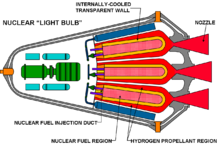From Wikipedia, the free encyclopedia
This type of reactor shows great promise in both of these roles. As a rocket engine it, like all nuclear rocket designs, can greatly exceed the power density of a chemical rocket. However, it also does not involve the release of any radioactive material from the rocket, unlike other nuclear designs which would cause nuclear fallout if used in a planetary atmosphere (e.g. Project Orion). As a method to generate electricity, nuclear lightbulbs are extremely efficient because higher-temperature heat contains more Gibbs free energy than the low-temperature heat produced in current fossil-fuel plants and water-cooled nuclear reactors. The theoretical specific impulse (Isp) range from 1500 to 3000 seconds.

No comments:
Post a Comment